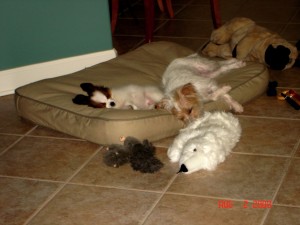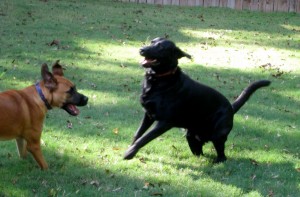 People often tell dog owners with high energy dogs causing problems to add another dog. Imagine this scenario. Your 7 month old Labrador Retriever is driving you nuts. Walter has so much energy, you can’t seem to wear him out. You take him on 2, 30 minute walks every day, one in the morning and one when you get home from work. He is crated during the day, because Walter would “remodel” your house otherwise.
People often tell dog owners with high energy dogs causing problems to add another dog. Imagine this scenario. Your 7 month old Labrador Retriever is driving you nuts. Walter has so much energy, you can’t seem to wear him out. You take him on 2, 30 minute walks every day, one in the morning and one when you get home from work. He is crated during the day, because Walter would “remodel” your house otherwise.
Every evening, you play fetch for at least an hour. You want to teach Walter some obedience commands, but with your busy schedule, you just don’t get around to it.
Walter knows sit, and will usually come when called, unless he sees a squirrel or other dogs.
People tell you, “Get another dog. They can play and exercise together.”
This sounds like a great idea! If you add another dog, a playmate for Walter, they can wear each other out. Walter will have a friend and your life will be easier. Right?
Things to consider:
Can I afford the expense of another dog?
Expect to spend anywhere from $60 – $235 per month, per dog.
Will Walter get along with my new dog?
There is always the chance that your friend for Walter may become his enemy! Managing a multi-dog household can be tricky, especially if the dogs are untrained. They might fight over your attention, rawhide chews, or that perfect spot on the sofa. In addition, if your current dog is a senior dog, he or she will probably not enjoy an exuberant puppy jumping and nipping. If you add a puppy to your home with an older dog it’s your responsibility to keep the puppy from annoying the older dog.
How will I find the time to train 3 dogs?
When you have 2 dogs, you have the training workload of owning 3 dogs. You’ll need to train Dog A, when Dog B is not nearby. Then you’ll train Dog B, when Dog A is not around. Great, now you have two dogs that will listen to you. Put them together and it all goes down the drain! The dogs act differently when they are together. They are another Dog, let’s call this one Dog AB. So, you really have 3 dogs to train. Train Dog A, Dog B, then train Dog AB.
Will I become a 3rd wheel?
Anyone who has litter mates can tell you. They become very accustomed to each other, so much so that they become anxious when separated. If you have time to work with each dog, without the other dog nearby, you can remain relevant. If the 2 dogs are always together, they may become one unit. And you may be the 3rd wheel.
What if both dogs chew up my stuff?
Dogs play in many ways. They chase each other, wrestle, jump and mouth each other. AND, dog dig together, hunt together and chew together. Monkey see, monkey do! One dog may never dig, but when the other starts, he or she may decide to dig too! Two dogs can destroy a set of patio furniture, or remodel a couch much quicker than 1 dog!
Will Walter teach my new dog bad habits? Or vice versa?
Dogs feed off each other’s ill manners. For instance suppose Walter is a friendly guy to everyone. He watches out the window at passing dogs and people, and rarely barks or jumps at the window. Enter new dog, who is always on patrol, barking and jumping at the window anytime anyone passes by. Walter watches and then decides to get into the act. Now you have two dogs barking and jumping! House training is another issue. If one dog has accidents inside, it’s likely that the other dog will too! Some dogs start to mark their territory when another dog is introduced. So, a problem that did not exist before is dropped into your lap!
Conclusion
When you add dogs to the house hold, you are taking on a greater responsibility for training and meeting the social, physical and emotional needs of your pets. I never suggest that a client add a dog if they are having trouble meeting the needs of 1 dog. On the flip side, if the client has one, well balanced trained dog, another dog could be a great addition!
Alan J Turner – Howsbentley
Dog Trainer – Memphis TN
 Your puppy’s training starts the minute you bring that little furry critter home!
Your puppy’s training starts the minute you bring that little furry critter home! 




